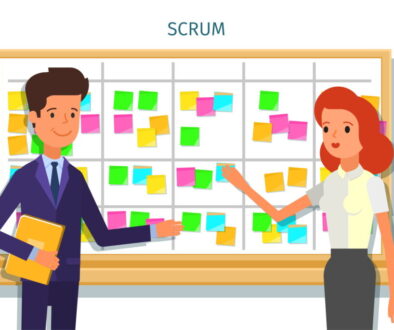Agile is not Scrum
When looking for information on Agile, software development is the most common industry represented. Within those results more often than not Scrum is used as the implementation. Many articles that try to talk about Agile in a generic sense use terminology from Scrum. A common side effect of this is that many people associate Agile and Scrum on a 1 to 1 level. This is a problem.
Agile is flexible.
In learning about Agile I have come to realize that one of the main concepts is that we do not know what we do not know. As we go through a project there will be new information. In being Agile we admit that up front. We start the project when we have the least information needed. We often take breaks to see what we have learned along with what that changes along the way. Most importantly, we allow those changes to occur whether they are to the project or our process.
Scrum is well-defined.
To be considered Scrum there are very specific rules that must be adhered to. If any of them are missing Scrum is not truly taking place. If any of them are in place in name only then at best “Scrum-but” is taking place. The entirety of what is required for Scrum to happen can be condensed into a 16 page guide or a 20 page primer. Nothing more and nothing less is required to be Scrum.
Agile guides decision.
The heart of Agile is a set of values. Drilling down to the next level of Agile as defined for software development are a set of guiding principles. In none of the values or principles is an edict for activity made. They are all ideals to keep at the forefront of decision-making. They are meant to shape how a project is approached, not dictate the method used for accomplishing work.
Scrum dictates process structure.
The heart of scrum is a set of roles, events, and artifacts. The roles people play on a project team are consolidated to one of three named positions. There are specific meetings that must take place every iteration. Work must be structured and queued in a certain way. Inside of this defined shell is Scrum. Outside of it is something else.
Agile is a way of thinking.
Agile thinking can benefit any project. Agile thinking is also something that can be done in many different working environments. An Emergency Room can be run as an Agile project using a method such as Kanban. Agile thinking is open thinking. Open to change. Open to improvement. Open to modifications. Agile thinking allows for bonds to be as broad as practical.
Scrum is a framework for getting work done.
Scrum is specific to product development, specifically software development. Scrum allows for flexibility, but only inside of the framework. Anything that is outside of the framework is an addition to scrum. It is allowed, but only if it does not undermine the framework itself. Anything removed from the framework means Scrum is no longer happening.
Scrum is Agile but Agile is not Scrum.
Just as all Fords are vehicles but not all vehicles are Fords Scrum is Agile but Agile is not Scrum. Scrum is something that, when used properly, is Agile. It allows for constant, short feedback cycles. It allows for continuous improvement. It gives transparency to the people who need it. Agile allows for more. Agile allows the framework to change as needed to best deliver value to the customer. Agile allows people to be placed in front of defined roles.
Scrum is a good place to start an Agile journey. It is simple on paper and in concept. It is widespread and shows a lot of success over the last decade. It is well understood and the benefits can easily be explained to the organization at large. The structure for Scrum can be mapped out and placed in an organization in a very short time frame. As an Agile Coach I would default to Scrum for most software development environments at the outset. In the end though, Agile needs to be more important than Scrum. Scrum is going to work. It might even be the best solution. Once a team trends towards high-performing the framework of Scrum must not be a limiting factor in improving the product and performance of that team. For this reason, even though I would start with Scrum, as an Agile Coach I would be open to Scrum-but over Pure Scrum in more cases than I would be blatantly against it.




January 21, 2014 @ 4:24 pm
Finally! A succinct & simple explanation of how Agile & Scrum fit together. I can now stop pretending I know the difference. 🙂
Pete, Cambridge Uk
January 27, 2014 @ 12:03 am
I’m glad this comes across as clear. It’s something that I’ve been seeing as I look to others experiences as well as in my own. It seems to stem from people going straight for doing a scrum implementation without any idea of the greater Agile world that it comes from.
January 22, 2014 @ 9:45 pm
I agree
see my posts on agile at agileinsights.wordpress.com
January 26, 2014 @ 11:56 pm
Thank you. I’m looking forward to gaining new insights into Agile from your blog.
Agile is NOT SCRUM | Project Research
January 26, 2014 @ 8:14 pm
[…] https://ouragilejourney.com/2013/11/12/agile-is-not-scrum/ , Posted by […]
Agile is NOT SCRUM | All that Cuteness
January 26, 2014 @ 8:15 pm
[…] https://ouragilejourney.com/2013/11/12/agile-is-not-scrum/ , Posted by […]
February 3, 2014 @ 2:29 pm
@Adam – This little dynamo write-up needs to go viral !
Thank you for this exceptionally clear, correct and concise correction to a common and pervasive misconception. You got it. I fear [we] are a minority. Let’s change this.
Jouney on!
~ Jim Bo
February 4, 2014 @ 3:47 pm
Even as a PSM 1 I feel Scrum needs to be acknowledged as a tool, not the end all be all solution. Too many places seem to think that the Agile Journey is nothing more than Implementing Scrum with minimal training to the development team only and letting it be. In reading through your blog I’m seeing we share many thoughts on the matter!
May 12, 2014 @ 11:35 pm
any suggestions for onine scrum certification?
May 22, 2014 @ 12:38 pm
I did a couple of articles on the CSM versus PSM certifications. The second one (which links back to the first one) can be found here: http://wp.me/p3QQod-41.
For a short answer I would say if you are pursuing online then go for a PSM and use your existing knowledge plus self-studying for the exam. Use the Scrum Guide to study. If you don’t have the knowledge or experience then I highly recommend going for the CSM via an in person class. I personally hope to get into one of the classes myself as the networking and learning from others is quite valuable in my mind. Also adding the CSM to my PSM would be a nice benefit.
If you’re really looking for Agile Project Management as a career path then when you do find CSM training look for one that is compbined CSM/PMI-ACP.